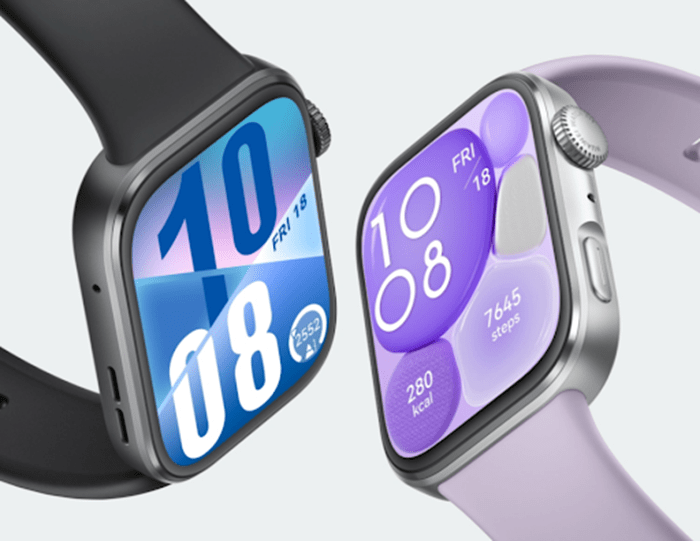
Smartwatches have evolved from simple timekeeping devices to essential tools that enhance daily life. In 2025, these wearables offer advanced features that cater to health monitoring, communication, and personal productivity. With the integration of cutting-edge technologies, smartwatches are becoming indispensable companions for individuals seeking convenience and connectivity on the go. This article delves into the emerging trends, design innovations, and market dynamics shaping the future of smartwatches. As the lines between technology and personal wellness continue to blur, understanding these developments is crucial for consumers and industry stakeholders alike. Notably, the Huawei Fit 4 exemplifies this evolution, offering a 1.82-inch AMOLED display, built-in GPS, and up to 10 days of battery life, positioning itself as a competitive option in the wearable tech market .
Emerging Trends in Smartwatch Technology
The smartwatch industry is witnessing rapid advancements, introducing features that redefine user experience. Let’s explore the key technological trends driving this evolution.
Health Monitoring and Wellness Features
Modern smartwatches are equipped with sophisticated health monitoring capabilities. Features such as heart rate tracking, sleep analysis, and stress level assessments have become standard. These devices provide real-time insights, enabling users to make informed decisions about their well-being. Advanced sensors detect irregularities, prompting timely medical consultations. Additionally, integration with health apps allows for comprehensive tracking of fitness goals and daily activities. In 2025, smartwatches are also exploring non-invasive glucose monitoring and hydration tracking, offering a more holistic approach to health management.
Integration with AI and Machine Learning
Artificial intelligence (AI) and machine learning are enhancing smartwatch functionalities. These technologies enable personalized user experiences by analyzing behavior patterns and preferences. Smartwatches can now predict user needs, suggest optimal workout routines, and even detect potential health issues before they become critical. Continuous learning algorithms ensure that the device adapts over time, offering increasingly accurate and relevant insights. Furthermore, AI integration facilitates improved voice recognition and natural language processing, making interactions with smartwatches more intuitive and efficient.
Design and User Experience Innovations
Beyond functionality, design and user experience play pivotal roles in smartwatch adoption. Manufacturers are focusing on aesthetics and intuitive interfaces to attract a broader audience.
Customization and Personalization
Personalization is at the forefront of smartwatch design. Users can choose from a variety of watch faces, straps, and materials to match their style and preferences. Software customization options allow for tailored notifications, widgets, and app layouts. This level of personalization ensures that the device aligns seamlessly with the user’s lifestyle and needs. In 2025, advancements in modular design are enabling users to swap out components, such as sensors and batteries, to further tailor their devices. This modularity not only enhances user satisfaction but also promotes sustainability by reducing electronic waste. For those who appreciate personalization and elegance beyond smartwatches, you can also browse TUDOR female watches at Kee Hing Hung to find timepieces that reflect your individual style.
Enhanced User Interfaces
User interfaces have become more intuitive and responsive. Touchscreens with haptic feedback, voice control, and gesture recognition are standard features. Smartwatches now offer seamless navigation through simplified menus and customizable shortcuts. Integration with virtual assistants allows for hands-free operation, enhancing accessibility and convenience. In 2025, developments in augmented reality (AR) are beginning to influence smartwatch interfaces, providing users with immersive experiences and real-time data overlays. These innovations are transforming smartwatches into more interactive and engaging devices.
Market Outlook and Consumer Adoption
The smartwatch market is experiencing significant growth, driven by technological advancements and increasing consumer demand. Let’s examine the market projections and consumer behavior shaping this industry.
Growth Projections and Market Leaders
The global smartwatch market is projected to grow from $42.5 billion in 2025 to $92 billion by 2034, with a compound annual growth rate (CAGR) of 9% . This growth is fueled by the integration of health monitoring features, AI capabilities, and fashionable designs. Emerging markets in Asia-Pacific are also contributing to the expansion, with increasing adoption rates and technological advancements. Key players are investing in research and development to stay ahead in this competitive landscape, focusing on innovation and user-centric designs. Collaborations between tech companies and fashion brands are further driving market growth by appealing to a broader consumer base.
Consumer Preferences and Usage Patterns
Consumers prioritize health tracking, battery life, and seamless connectivity in smartwatches. Features like fitness monitoring, sleep analysis, and smartphone integration are highly valued. Personalization options and aesthetic appeal also influence purchasing decisions. Users seek devices that align with their lifestyle, offering both functionality and style. The trend towards hybrid smartwatches, combining traditional watch designs with smart features, is gaining popularity among consumers seeking a balance between technology and classic aesthetics. Additionally, the growing awareness of health and wellness is prompting users to invest in smartwatches as proactive health management tools. As a result, manufacturers are focusing on developing features that cater to these evolving consumer needs.
Conclusion
Smartwatches have transformed into multifaceted devices that enhance health, productivity, and personal expression. The integration of advanced health monitoring, AI-driven personalization, and customizable designs reflects the industry’s commitment to meeting diverse consumer needs. As technology continues to advance, smartwatches will play an increasingly vital role in our daily lives, offering innovative solutions that blend functionality with style. Staying informed about these trends will help consumers make educated choices and embrace the future of wearable technology. Furthermore, the emphasis on sustainability and modularity in smartwatch design is expected to resonate with environmentally conscious consumers. As the market evolves, collaboration between technology and fashion industries will likely yield devices that are not only functional but also fashion-forward. In conclusion, the future of smartwatches is bright, with endless possibilities for innovation and personalization.




